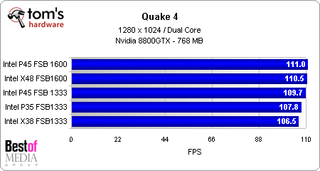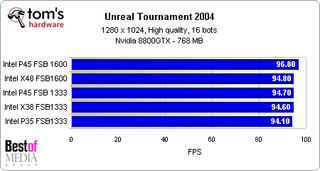Intel P45: The New Chipset Lacks Progress
Performance Benchmark Results
Although Intel officially supports only 1333 MHz FSB speeds, many motherboard manufacturers decided to support 1600 MHz settings as well, so we benchmarked both. In an effort to directly assess the performance difference, we reduced the Core 2 Extreme Q9770’s core clock speed from 3.2 GHz to 3.0 GHz, as this would allow running 3.0 GHz either at 1333 MHz or 1600 MHz.
We selected DDR2-800 memory at CL4-4-4-12 timings for all benchmark runs. Please note that the X48 motherboard we used utilized DDR3 memory, so we had to switch to DDR3-1066.
We ran all benchmarks at least three times, and used the average result of all benchmark runs. As you will see, there is no clear performance winner, as the differences are too small. This includes the enthusiast X38 and X48 chipsets, as well as the mainstream P35 and P45 chipsets, and 1333 MHz versus 1600 MHz—the effective difference is close to zero.
3D Benchmarks

Prey delivers slightly faster frame rates when running on a host system that operates at 1600 MHz speed. However, the difference is too small to justify purchasing an expensive X48 motherboard over one using P45 or P35, unless you want dual x16 PCI Express 2.0 graphics.

We only use Quake 4 for platform benchmarks as it is not graphics limited due to its outdated graphics feature set. As a consequence, the platform typically creates the bottleneck. Here you can see that 1600 MHz does make a difference, but again the performance benefits are really small.

Different benchmark, same results: there are only minor performance improvements for 1600 MHz over 1333 MHz bus speeds.
Stay On the Cutting Edge: Get the Tom's Hardware Newsletter
Get Tom's Hardware's best news and in-depth reviews, straight to your inbox.

Current page: Performance Benchmark Results
Prev Page Benchmarks and Settings Next Page Application BenchmarksMost Popular



